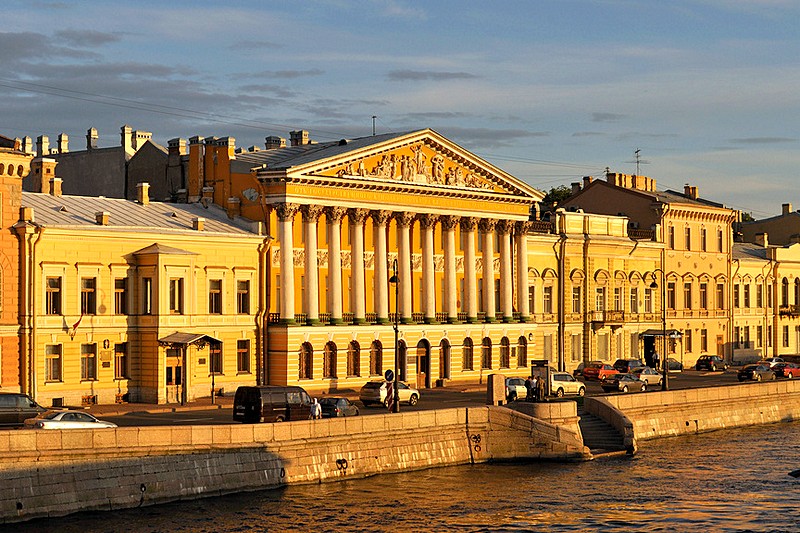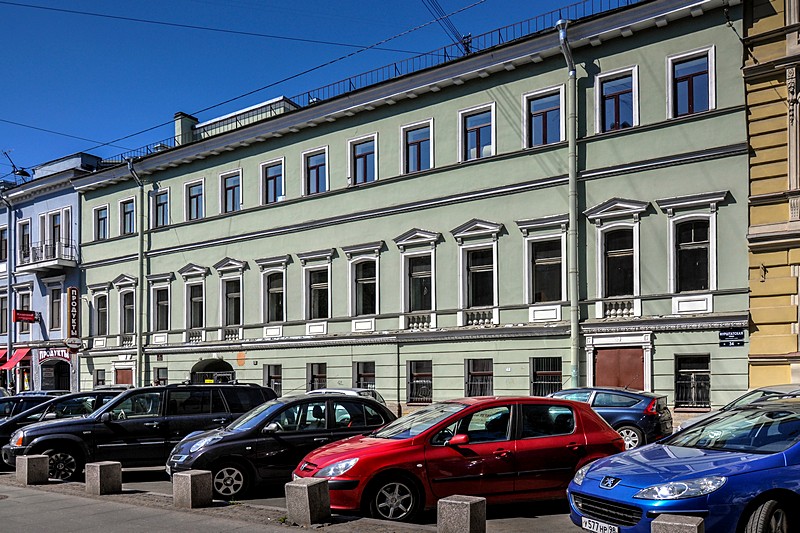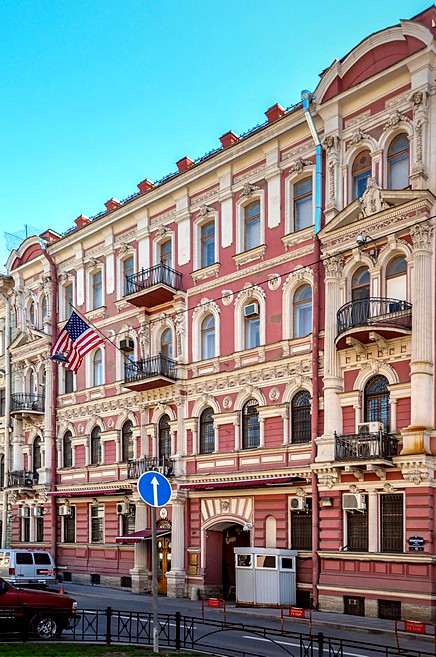American walks through St. Petersburg
Somewhat ironically, our tour of American sites in St. Petersburg begins on the English Embankment (Angliiskaya Naberezhnaya), where several addresses are connected with American life in the city. Two buildings on the embankment have been home to the US Embassy - the beautiful neo-renaissance Mansion of Baron von Derviz at No. 27 (1897-1903), and at No. 44 the splendid Mansion of Count Rumyantsev (1908-1909), which now houses part of the Museum of St. Petersburg in superbly restored interiors.
The great American railway engineer, George Washington Whistler, lived from 1842 to 1849 at No. 34, along with his son, the painter James Abbot Mcneill Whistler, who as a young boy would cross the ice of the River Neva in winter to attend classes at the Imperial Academy of Fine Arts.

Turning off the embankment along Proyezd Dekabristov and onto St. Isaac's Square, we can see across the Blue Bridge at No. 66, Naberezhnaya Reki Moyki, the Yakunchikova House (Volodarskiy House of Culture), which bears a plaque stating: "Here in 1810-1811 lived the first envoy of the USA to Russia, John Quincy Adams, sixth President of the United States of America".
Without crossing the bridge, we turn right along Bolshaya Morskaya Ulitsa, where at No. 47 we can find the attractive Art Nouveau facades of the Nabokov House, where the great author Vladimir Nabokov, whose life and art indelibly ties St. Petersburg and the USA, was born and raised. It is now home to a museum which celebrates his passions for literature and lepidoptery, and works to strengthen the links between Nabokov enthusiasts in Russia and the United States.
We then turn back up Bolshaya Morskaya Ulitsa to No. 23, where John Paul Jones, naval hero of the American Revolutionary War, lived 1788-1789 while serving Catherine the Great in the Imperial Russian Navy, and where he wrote his memoirs. His time is also marked with a plaque on the building's facade.

Following Bolshaya Morskaya to the junction with Nevsky Prospekt, we turn right, walking to the Griboedov Canal crossing, where at No. 28 stands one of St. Petersburg's most striking and famous buildings, the Singer Building or Dom Knigi, the Art Nouveau masterpiece constructed 1902-1904 as the Russian headquarters and showrooms of the Singer Corporation, the New York manufacturer of sewing machines. In its at the time scandalous design, the architect Pavel Syuzor attempted to recreate the modern glamour of Singer's home city within the strict limitations of St. Petersburg building codes.
It is a now a few hundred meters' walk along Nevsky Prospekt until we cross the Fontanka River. At the corner of Ulitsa Rubinshteina (which is, incidentally, the site of the city's first McDonald's outlet), we turn right and walk about 200m down the street to No. 13. The building now houses the Zazerkale Children's Musical Theatre, but in the 1980s it was home to the Leningrad Rock Club, the first semi-official venue permitted by the Soviet authorities where local musicians could gather and perform their degenerate, American-inspired music. It was also here that the young American singer Joana Stingray was introduced to the bands she went on to release in Los Angeles on the Red Wave compilation in 1986, the first official album of Soviet rock music in the world.

Turning back to Nevsky Prospekt, we cross the road and turn left up Liteyny Prospekt. Walking up this long avenue, we pass two sites connected with the Nobel Prize-winning Russian-American poet Joseph Brodsky. First, in the courtyard of No. 53, is the Anna Akhmatova Museum in the Fountain House. A major figure of the Russian Silver Age of poetry, Akhmatova became a mentor to the young Brodsky, and there is a room in the museum dedicated to his life and work in America. At No. 24, meanwhile, on the Muruzi House, one of the most beautiful apartment buildings in St. Petersburg, a plaque commemorates the fact that Brodsky lived here with his parents in a communal apartment from 1955 until he was expelled from the USSR in 1972. It is hoped that there will soon be a museum here in his honour.
Continuing along Liteyny Prospekt, we take the next turning on the right onto Furshtatskaya Ulitsa. The modern Consulate of the USA in St. Petersburg is located at No. 15, while a little further down the street at No. 34 is the Count Grabbe House, which was the last location of the US Embassy in Petrograd before it moved to Moscow in 1918.

A few steps further along Furshtatskaya Ulitsa bring us to Chernyshevskaya Metro Station, from where we travel one stop south on the red line to Ploshchad Vosstaniya. The building on the corner of Nevsky Prospekt and Ploshchad Vosstaniya (on the eastern side of the square) was formerly the site of a pharmacist's store managed and owned (along with the rest of the building) from 1910-1917 by Salman Wolf-Rosenbaum, father of Ayn Rand, the bestselling American novelist and founder of the philosophical movement of Objectivism. Rand and her family lived in an apartment above the store, and it was here that she began to write as a very small child, supposedly completing four novels by the age of 11.
The dominating feature of Ploshchad Vosstaniya, however, is the Moscow Railway Station, which marks the beginning of the 600km railroad between St. Petersburg and Moscow, the construction of which was supervised from 1842 to 1849 by George Washington Whistler, the American engineer invited by Tsar Nicholas I to St. Petersburg for on the project. A short way down the tracks, where the railroad crosses the Obvodny Canal, the American Bridges (Amerikanskiye Mosty) are named in his honour, adapted from designs by another American, William Howe. The first major railroad in Russia, Washington's work was also the first time that the Russian Imperial Government had turned to the US rather than Europe for technical expertise, and as such it makes a fitting place to end out American tour of St. Petersburg.

